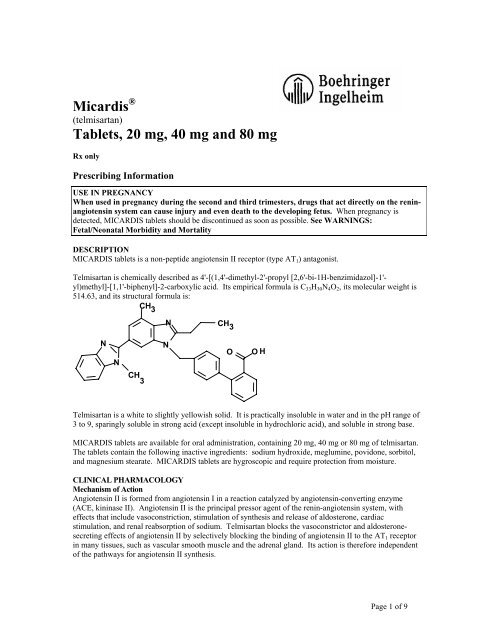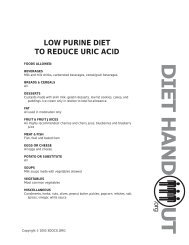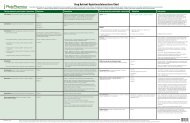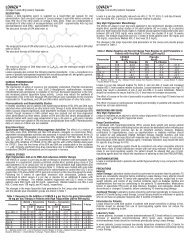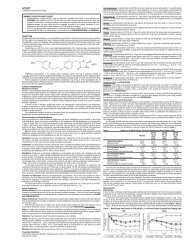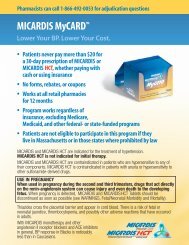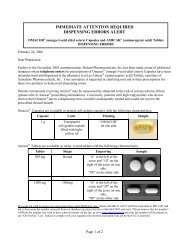Micardis Tablets, 20 mg, 40 mg and 80 mg - Pharmacist eLink
Micardis Tablets, 20 mg, 40 mg and 80 mg - Pharmacist eLink
Micardis Tablets, 20 mg, 40 mg and 80 mg - Pharmacist eLink
Create successful ePaper yourself
Turn your PDF publications into a flip-book with our unique Google optimized e-Paper software.
<strong>Micardis</strong> ®<br />
(telmisartan)<br />
<strong>Tablets</strong>, <strong>20</strong> <strong>mg</strong>, <strong>40</strong> <strong>mg</strong> <strong>and</strong> <strong>80</strong> <strong>mg</strong><br />
Rx only<br />
Prescribing Information<br />
USE IN PREGNANCY<br />
When used in pregnancy during the second <strong>and</strong> third trimesters, drugs that act directly on the reninangiotensin<br />
system can cause injury <strong>and</strong> even death to the developing fetus. When pregnancy is<br />
detected, MICARDIS tablets should be discontinued as soon as possible. See WARNINGS:<br />
Fetal/Neonatal Morbidity <strong>and</strong> Mortality<br />
DESCRIPTION<br />
MICARDIS tablets is a non-peptide angiotensin II receptor (type AT 1 ) antagonist.<br />
Telmisartan is chemically described as 4'-[(1,4'-dimethyl-2'-propyl [2,6'-bi-1H-benzimidazol]-1'-<br />
yl)methyl]-[1,1'-biphenyl]-2-carboxylic acid. Its empirical formula is C 33 H 30 N 4 O 2 , its molecular weight is<br />
514.63, <strong>and</strong> its structural formula is:<br />
CH 3<br />
N<br />
CH 3<br />
N<br />
N<br />
N<br />
O<br />
O H<br />
CH 3<br />
Telmisartan is a white to slightly yellowish solid. It is practically insoluble in water <strong>and</strong> in the pH range of<br />
3 to 9, sparingly soluble in strong acid (except insoluble in hydrochloric acid), <strong>and</strong> soluble in strong base.<br />
MICARDIS tablets are available for oral administration, containing <strong>20</strong> <strong>mg</strong>, <strong>40</strong> <strong>mg</strong> or <strong>80</strong> <strong>mg</strong> of telmisartan.<br />
The tablets contain the following inactive ingredients: sodium hydroxide, meglumine, povidone, sorbitol,<br />
<strong>and</strong> magnesium stearate. MICARDIS tablets are hygroscopic <strong>and</strong> require protection from moisture.<br />
CLINICAL PHARMACOLOGY<br />
Mechanism of Action<br />
Angiotensin II is formed from angiotensin I in a reaction catalyzed by angiotensin-converting enzyme<br />
(ACE, kininase II). Angiotensin II is the principal pressor agent of the renin-angiotensin system, with<br />
effects that include vasoconstriction, stimulation of synthesis <strong>and</strong> release of aldosterone, cardiac<br />
stimulation, <strong>and</strong> renal reabsorption of sodium. Telmisartan blocks the vasoconstrictor <strong>and</strong> aldosteronesecreting<br />
effects of angiotensin II by selectively blocking the binding of angiotensin II to the AT 1 receptor<br />
in many tissues, such as vascular smooth muscle <strong>and</strong> the adrenal gl<strong>and</strong>. Its action is therefore independent<br />
of the pathways for angiotensin II synthesis.<br />
Page 1 of 9
There is also an AT 2 receptor found in many tissues, but AT 2 is not known to be associated with<br />
cardiovascular homeostasis. Telmisartan has much greater affinity (>3,000 fold) for the AT 1 receptor than<br />
for the AT 2 receptor.<br />
Blockade of the renin-angiotensin system with ACE inhibitors, which inhibit the biosynthesis of<br />
angiotensin II from angiotensin I, is widely used in the treatment of hypertension. ACE inhibitors also<br />
inhibit the degradation of bradykinin, a reaction also catalyzed by ACE. Because telmisartan does not<br />
inhibit ACE (kininase II), it does not affect the response to bradykinin. Whether this difference has clinical<br />
relevance is not yet known. Telmisartan does not bind to or block other hormone receptors or ion channels<br />
known to be important in cardiovascular regulation.<br />
Blockade of the angiotensin II receptor inhibits the negative regulatory feedback of angiotensin II on renin<br />
secretion, but the resulting increased plasma renin activity <strong>and</strong> angiotensin II circulating levels do not<br />
overcome the effect of telmisartan on blood pressure.<br />
Pharmacokinetics<br />
General<br />
Following oral administration, peak concentrations (C max ) of telmisartan are reached in 0.5-1 hour after<br />
dosing. Food slightly reduces the bioavailability of telmisartan, with a reduction in the area under the<br />
plasma concentration-time curve (AUC) of about 6% with the <strong>40</strong> <strong>mg</strong> tablet <strong>and</strong> about <strong>20</strong>% after a 160 <strong>mg</strong><br />
dose. The absolute bioavailability of telmisartan is dose dependent. At <strong>40</strong> <strong>and</strong> 160 <strong>mg</strong> the bioavailability<br />
was 42% <strong>and</strong> 58%, respectively. The pharmacokinetics of orally administered telmisartan are nonlinear<br />
over the dose range <strong>20</strong>-160 <strong>mg</strong>, with greater than proportional increases of plasma concentrations (C max <strong>and</strong><br />
AUC) with increasing doses. Telmisartan shows bi-exponential decay kinetics with a terminal elimination<br />
half life of approximately 24 hours. Trough plasma concentrations of telmisartan with once daily dosing are<br />
about 10-25% of peak plasma concentrations. Telmisartan has an accumulation index in plasma of 1.5 to<br />
2.0 upon repeated once daily dosing.<br />
Metabolism <strong>and</strong> Elimination<br />
Following either intravenous or oral administration of 14 C-labeled telmisartan, most of the administered<br />
dose (>97%) was eliminated unchanged in feces via biliary excretion; only minute amounts were found in<br />
the urine (0.91% <strong>and</strong> 0.49% of total radioactivity, respectively).<br />
Telmisartan is metabolized by conjugation to form a pharmacologically inactive acylglucuronide; the<br />
glucuronide of the parent compound is the only metabolite that has been identified in human plasma <strong>and</strong><br />
urine. After a single dose, the glucuronide represents approximately 11% of the measured radioactivity in<br />
plasma. The cytochrome P450 isoenzymes are not involved in the metabolism of telmisartan.<br />
Total plasma clearance of telmisartan is ><strong>80</strong>0 mL/min. Terminal half-life <strong>and</strong> total clearance appear to be<br />
independent of dose.<br />
Distribution<br />
Telmisartan is highly bound to plasma proteins (>99.5%), mainly albumin <strong>and</strong> α 1 - acid glycoprotein.<br />
Plasma protein binding is constant over the concentration range achieved with recommended doses. The<br />
volume of distribution for telmisartan is approximately 500 liters indicating additional tissue binding.<br />
Special Populations<br />
Pediatric: Telmisartan pharmacokinetics have not been investigated in patients
Renal Insufficiency: No dosage adjustment is necessary in patients with decreased renal function.<br />
Telmisartan is not removed from blood by hemofiltration (see PRECAUTIONS <strong>and</strong> DOSAGE AND<br />
ADMINISTRATION).<br />
Hepatic Insufficiency: In patients with hepatic insufficiency, plasma concentrations of telmisartan are<br />
increased, <strong>and</strong> absolute bioavailability approaches 100% (see PRECAUTIONS <strong>and</strong> DOSAGE AND<br />
ADMINISTRATION).<br />
Drug Interactions: See PRECAUTIONS, Drug Interactions.<br />
Pharmacodynamics<br />
In normal volunteers, a dose of telmisartan <strong>80</strong> <strong>mg</strong> inhibited the pressor response to an intravenous infusion<br />
of angiotensin II by about 90% at peak plasma concentrations with approximately <strong>40</strong>% inhibition persisting<br />
for 24 hours.<br />
Plasma concentration of angiotensin II <strong>and</strong> plasma renin activity (PRA) increased in a dose-dependent<br />
manner after single administration of telmisartan to healthy subjects <strong>and</strong> repeated administration to<br />
hypertensive patients. The once-daily administration of up to <strong>80</strong> <strong>mg</strong> telmisartan to healthy subjects did not<br />
influence plasma aldosterone concentrations. In multiple dose studies with hypertensive patients, there<br />
were no clinically significant changes in electrolytes (serum potassium or sodium), or in metabolic function<br />
(including serum levels of cholesterol, triglycerides, HDL, LDL, glucose, or uric acid).<br />
In 30 hypertensive patients with normal renal function treated for 8 weeks with telmisartan <strong>80</strong> <strong>mg</strong> or<br />
telmisartan <strong>80</strong> <strong>mg</strong> in combination with hydrochlorothiazide 12.5 <strong>mg</strong>, there were no clinically significant<br />
changes from baseline in renal blood flow, glomerular filtration rate, filtration fraction, renovascular<br />
resistance, or creatinine clearance.<br />
Clinical Trials<br />
The antihypertensive effects of <strong>Micardis</strong>® (telmisartan) tablets have been demonstrated in six principal<br />
placebo-controlled clinical trials, studying a range of <strong>20</strong>-160 <strong>mg</strong>; one of these examined the<br />
antihypertensive effects of telmisartan <strong>and</strong> hydrochlorothiazide in combination. The studies involved a<br />
total of 1773 patients with mild to moderate hypertension (diastolic blood pressure of 95-114 mmHg), 1031<br />
of whom were treated with telmisartan. Following once daily administration of telmisartan, the magnitude<br />
of blood pressure reduction from baseline after placebo subtraction was approximately (SBP/DBP) 6-8/6<br />
mmHg for <strong>20</strong> <strong>mg</strong>, 9-13/6-8 mmHg for <strong>40</strong> <strong>mg</strong>, <strong>and</strong> 12-13/7-8 mmHg for <strong>80</strong> <strong>mg</strong>. Larger doses (up to 160<br />
<strong>mg</strong>) did not appear to cause a further decrease in blood pressure.<br />
Upon initiation of antihypertensive treatment with telmisartan, blood pressure was reduced after the first<br />
dose, with a maximal reduction by about 4 weeks. With cessation of treatment with MICARDIS tablets,<br />
blood pressure gradually returned to baseline values over a period of several days to one week. During<br />
long term studies (without placebo control) the effect of telmisartan appeared to be maintained for up to at<br />
least one year. The antihypertensive effect of telmisartan is not influenced by patient age, gender, weight<br />
or body mass index. Blood pressure response in black patients (usually a low-renin population) is<br />
noticeably less than that in Caucasian patients. This has been true for most, but not all, angiotensin II<br />
antagonists <strong>and</strong> ACE inhibitors.<br />
In a controlled study, the addition of telmisartan to hydrochlorothiazide produced an additional dose-related<br />
reduction in blood pressure that was similar in magnitude to the reduction achieved with telmisartan<br />
monotherapy. Hydrochlorothiazide also had an added blood pressure effect when added to telmisartan.<br />
The onset of antihypertensive activity occurs within 3 hours after administration of a single oral dose. At doses of<br />
<strong>20</strong>, <strong>40</strong>, <strong>and</strong> <strong>80</strong> <strong>mg</strong>, the antihypertensive effect of once daily administration of telmisartan is maintained for the full<br />
24-hour dose interval. With automated ambulatory blood pressure monitoring <strong>and</strong> conventional blood pressure<br />
measurements, the 24-hour trough-to-peak ratio for <strong>40</strong>-<strong>80</strong> <strong>mg</strong> doses of telmisartan was 70-100% for both systolic<br />
<strong>and</strong> diastolic blood pressure. The incidence of symptomatic orthostasis after the first dose in all controlled trials<br />
was low (0.04%).<br />
Page 3 of 9
There were no changes in the heart rate of patients treated with telmisartan in controlled trials.<br />
INDICATIONS AND USAGE<br />
<strong>Micardis</strong>® (telmisartan) tablets are indicated for the treatment of hypertension. It may be used alone or in<br />
combination with other antihypertensive agents.<br />
CONTRAINDICATIONS<br />
MICARDIS tablets are contraindicated in patients who are hypersensitive to any component of this product.<br />
WARNINGS<br />
Fetal/Neonatal Morbidity <strong>and</strong> Mortality<br />
Drugs that act directly on the renin-angiotensin system can cause fetal <strong>and</strong> neonatal morbidity <strong>and</strong> death<br />
when administered to pregnant women. Several dozen cases have been reported in the world literature in<br />
patients who were taking angiotensin converting enzyme inhibitors. When pregnancy is detected,<br />
MICARDIS tablets should be discontinued as soon as possible.<br />
The use of drugs that act directly on the renin-angiotensin system during the second <strong>and</strong> third trimesters of<br />
pregnancy has been associated with fetal <strong>and</strong> neonatal injury, including hypotension, neonatal skull<br />
hypoplasia, anuria, reversible or irreversible renal failure, <strong>and</strong> death. Oligohydramnios has also been<br />
reported, presumably resulting from decreased fetal renal function; oligohydramnios in this setting has been<br />
associated with fetal limb contractures, craniofacial deformation, <strong>and</strong> hypoplastic lung development.<br />
Prematurity, intrauterine growth retardation, <strong>and</strong> patent ductus arteriosus have also been reported, although<br />
it is not clear whether these occurrences were due to exposure to the drug.<br />
These adverse effects do not appear to have resulted from intrauterine drug exposure that has been limited<br />
to the first trimester. Mothers whose embryos <strong>and</strong> fetuses are exposed to an angiotensin II receptor<br />
antagonist only during the first trimester should be so informed. Nonetheless, when patients become<br />
pregnant, physicians should have the patient discontinue the use of MICARDIS tablets as soon as possible.<br />
Rarely (probably less often than once in every thous<strong>and</strong> pregnancies), no alternative to an angiotensin II<br />
receptor antagonist will be found. In these rare cases, the mothers should be apprised of the potential<br />
hazards to their fetuses, <strong>and</strong> serial ultrasound examinations should be performed to assess the intraamniotic<br />
environment.<br />
If oligohydramnios is observed, MICARDIS tablets should be discontinued unless they are considered lifesaving<br />
for the mother. Contraction stress testing (CST), a non-stress test (NST), or biophysical profiling<br />
(BPP) may be appropriate, depending upon the week of pregnancy. Patients <strong>and</strong> physicians should be<br />
aware, however, that oligohydramnios may not appear until after the fetus has sustained irreversible injury.<br />
Infants with histories of in utero exposure to an angiotensin II receptor antagonist should be closely<br />
observed for hypotension, oliguria, <strong>and</strong> hyperkalemia. If oliguria occurs, attention should be directed<br />
toward support of blood pressure <strong>and</strong> renal perfusion. Exchange transfusion or dialysis may be required as<br />
a means of reversing hypotension <strong>and</strong>/or substituting for disordered renal function.<br />
There is no clinical experience with the use of MICARDIS tablets in pregnant women. No teratogenic<br />
effects were observed when telmisartan was administered to pregnant rats at oral doses of up to 50<br />
<strong>mg</strong>/kg/day <strong>and</strong> to pregnant rabbits at oral doses up to 45 <strong>mg</strong>/kg/day. In rabbits, embryolethality associated<br />
with maternal toxicity (reduced body weight gain <strong>and</strong> food consumption) was observed at 45 <strong>mg</strong>/kg/day<br />
[about 12 times the maximum recommended human dose (MRHD) of <strong>80</strong> <strong>mg</strong> on a <strong>mg</strong>/m 2 basis]. In rats,<br />
maternally toxic (reduction in body weight gain <strong>and</strong> food consumption) telmisartan doses of 15 <strong>mg</strong>/kg/day<br />
(about 1.9 times the MRHD on a <strong>mg</strong>/m 2 basis), administered during late gestation <strong>and</strong> lactation, were<br />
observed to produce adverse effects in neonates, including reduced viability, low birth weight, delayed<br />
maturation, <strong>and</strong> decreased weight gain. Telmisartan has been shown to be present in rat fetuses during late<br />
gestation <strong>and</strong> in rat milk. The no observed effect doses for developmental toxicity in rats <strong>and</strong> rabbits, 5 <strong>and</strong><br />
Page 4 of 9
15 <strong>mg</strong>/kg/day, respectively, are about 0.64 <strong>and</strong> 3.7 times, on a <strong>mg</strong>/m 2 basis, the maximum recommended<br />
human dose of telmisartan (<strong>80</strong> <strong>mg</strong>/day).<br />
Hypotension in Volume-Depleted Patients<br />
In patients with an activated renin-angiotensin system, such as volume- <strong>and</strong>/or salt-depleted patients (e.g.,<br />
those being treated with high doses of diuretics), symptomatic hypotension may occur after initiation of<br />
therapy with <strong>Micardis</strong>® (telmisartan) tablets. This condition should be corrected prior to administration of<br />
MICARDIS tablets, or treatment should start under close medical supervision with a reduced dose.<br />
If hypotension does occur, the patient should be placed in the supine position <strong>and</strong>, if necessary, given an<br />
intravenous infusion of normal saline. A transient hypotensive response is not a contraindication to further<br />
treatment, which usually can be continued without difficulty once the blood pressure has stabilized.<br />
PRECAUTIONS<br />
General<br />
Impaired Hepatic Function: As the majority of telmisartan is eliminated by biliary excretion, patients<br />
with biliary obstructive disorders or hepatic insufficiency can be expected to have reduced clearance.<br />
MICARDIS tablets should be used with caution in these patients.<br />
Impaired Renal Function: As a consequence of inhibiting the renin-angiotensin-aldosterone system,<br />
changes in renal function may be anticipated in susceptible individuals. In patients whose renal function<br />
may depend on the activity of the renin-angiotensin-aldosterone system (e.g., patients with severe<br />
congestive heart failure), treatment with angiotensin-converting enzyme inhibitors <strong>and</strong> angiotensin receptor<br />
antagonists has been associated with oliguria <strong>and</strong>/or progressive azotemia <strong>and</strong> (rarely) with acute renal<br />
failure <strong>and</strong>/or death. Similar results may be anticipated in patients treated with MICARDIS tablets.<br />
In studies of ACE inhibitors in patients with unilateral or bilateral renal artery stenosis, increases in serum<br />
creatinine or blood urea nitrogen were observed. There has been no long term use of MICARDIS tablets in<br />
patients with unilateral or bilateral renal artery stenosis but an effect similar to that seen with ACE<br />
inhibitors should be anticipated.<br />
Dual Blockade of the Renin-angiotensin-aldosterone System: As a consequence of inhibiting the reninangiotensin-aldosterone<br />
system, changes in renal function (including acute renal failure) have been<br />
reported. Dual blockade of the renin-angiotensin-aldosterone system (e.g., by adding an ACE-inhibitor to<br />
an angiotensin II receptor antagonist) should be used with caution <strong>and</strong> should include close monitoring of<br />
renal function.<br />
Information for Patients<br />
Pregnancy: Female patients of childbearing age should be told about the consequences of second- <strong>and</strong><br />
third-trimester exposure to drugs that act on the renin-angiotensin system, <strong>and</strong> they should also be told that<br />
these consequences do not appear to have resulted from intrauterine drug exposure that has been limited to<br />
the first trimester. These patients should be asked to report pregnancies to their physicians as soon as<br />
possible.<br />
Drug Interactions<br />
Digoxin: When telmisartan was co-administered with digoxin, median increases in digoxin peak plasma<br />
concentration (49%) <strong>and</strong> in trough concentration (<strong>20</strong>%) were observed. It is, therefore, recommended that<br />
digoxin levels be monitored when initiating, adjusting, <strong>and</strong> discontinuing telmisartan to avoid possible<br />
over- or under-digitalization.<br />
Warfarin: Telmisartan administered for 10 days slightly decreased the mean warfarin trough plasma<br />
concentration; this decrease did not result in a change in International Normalized Ratio (INR).<br />
Other Drugs: Co-administration of telmisartan did not result in a clinically significant interaction with<br />
acetaminophen, amlodipine, glibenclamide, simvastatin, hydrochlorothiazide or ibuprofen. Telmisartan is<br />
not metabolized by the cytochrome P450 system <strong>and</strong> had no effects in vitro on cytochrome P450 enzymes,<br />
Page 5 of 9
except for some inhibition of CYP2C19. Telmisartan is not expected to interact with drugs that inhibit<br />
cytochrome P450 enzymes; it is also not expected to interact with drugs metabolized by cytochrome P450<br />
enzymes, except for possible inhibition of the metabolism of drugs metabolized by CYP2C19.<br />
Carcinogenesis, Mutagenesis, Impairment of Fertility<br />
There was no evidence of carcinogenicity when telmisartan was administered in the diet to mice <strong>and</strong> rats<br />
for up to 2 years. The highest doses administered to mice (1000 <strong>mg</strong>/kg/day) <strong>and</strong> rats (100 <strong>mg</strong>/kg/day) are,<br />
on a <strong>mg</strong>/m 2 basis, about 59 <strong>and</strong> 13 times, respectively, the maximum recommended human dose (MRHD) of<br />
telmisartan. These same doses have been shown to provide average systemic exposures to telmisartan >100 times<br />
<strong>and</strong> >25 times, respectively, the systemic exposure in humans receiving the MRHD (<strong>80</strong> <strong>mg</strong>/day).<br />
Genotoxicity assays did not reveal any telmisartan-related effects at either the gene or chromosome level.<br />
These assays included bacterial mutagenicity tests with Salmonella <strong>and</strong> E. coli (Ames), a gene mutation test<br />
with Chinese hamster V79 cells, a cytogenetic test with human lymphocytes, <strong>and</strong> a mouse micronucleus<br />
test.<br />
No drug-related effects on the reproductive performance of male <strong>and</strong> female rats were noted at 100<br />
<strong>mg</strong>/kg/day (the highest dose administered), about 13 times, on a <strong>mg</strong>/m 2 basis, the MRHD of telmisartan.<br />
This dose in the rat resulted in an average systemic exposure (telmisartan AUC as determined on day 6 of<br />
pregnancy) at least 50 times the average systemic exposure in humans at the MRHD (<strong>80</strong> <strong>mg</strong>/day).<br />
Pregnancy<br />
Pregnancy Categories C (first trimester) <strong>and</strong> D (second <strong>and</strong> third trimesters). See WARNINGS, Fetal/Neonatal<br />
Morbidity <strong>and</strong> Mortality.<br />
Nursing Mothers<br />
It is not known whether telmisartan is excreted in human milk, but telmisartan was shown to be present in<br />
the milk of lactating rats. Because of the potential for adverse effects on the nursing infant, a decision<br />
should be made whether to discontinue nursing or discontinue the drug, taking into account the importance<br />
of the drug to the mother.<br />
Pediatric Use<br />
Safety <strong>and</strong> effectiveness in pediatric patients have not been established.<br />
Geriatric Use<br />
Of the total number of patients receiving <strong>Micardis</strong>® (telmisartan) tablets in clinical studies, 551 (18.6%)<br />
were 65 to 74 years of age <strong>and</strong> 130 (4.4%) were 75 years or older. No overall differences in effectiveness<br />
<strong>and</strong> safety were observed in these patients compared to younger patients <strong>and</strong> other reported clinical<br />
experience has not identified differences in responses between the elderly <strong>and</strong> younger patients, but greater<br />
sensitivity of some older individuals cannot be ruled out.<br />
ADVERSE REACTIONS<br />
MICARDIS tablets have been evaluated for safety in more than 3700 patients, including 1900 treated for over six<br />
months <strong>and</strong> more than 1300 for over one year. Adverse experiences have generally been mild <strong>and</strong> transient in<br />
nature <strong>and</strong> have only infrequently required discontinuation of therapy.<br />
In placebo-controlled trials involving 1041 patients treated with various doses of telmisartan (<strong>20</strong>-160 <strong>mg</strong>)<br />
monotherapy for up to 12 weeks, an overall incidence of adverse events similar to that of placebo was observed.<br />
Adverse events occurring at an incidence of 1% or more in patients treated with telmisartan <strong>and</strong> at a greater rate<br />
than in patients treated with placebo, irrespective of their causal association, are presented in the following table.<br />
Page 6 of 9
______________________________________________________________________________________<br />
Telmisartan Placebo<br />
n = 1455 n = 3<strong>80</strong><br />
% %<br />
Upper respiratory tract infection 7 6<br />
Back pain 3 1<br />
Sinusitis 3 2<br />
Diarrhea 3 2<br />
Pharyngitis 1 0<br />
In addition to the adverse events in the table, the following events occurred at a rate of 1% but were at least<br />
as frequent in the placebo group: influenza-like symptoms, dyspepsia, myalgia, urinary tract infection,<br />
abdominal pain, headache, dizziness, pain, fatigue, coughing, hypertension, chest pain, nausea <strong>and</strong><br />
peripheral edema. Discontinuation of therapy due to adverse events was required in 2.8% of 1455 patients<br />
treated with <strong>Micardis</strong>® (telmisartan) tablets <strong>and</strong> 6.1% of 3<strong>80</strong> placebo patients in placebo-controlled clinical<br />
trials.<br />
The incidence of adverse events was not dose-related <strong>and</strong> did not correlate with gender, age, or race of<br />
patients.<br />
The incidence of cough occurring with telmisartan in six placebo-controlled trials was identical to that<br />
noted for placebo-treated patients (1.6%).<br />
In addition to those listed above, adverse events that occurred in more than 0.3% of 3500 patients treated<br />
with MICARDIS tablets monotherapy in controlled or open trials are listed below. It cannot be determined<br />
whether these events were causally related to MICARDIS tablets:<br />
Autonomic Nervous System: impotence, increased sweating, flushing; Body as a Whole: allergy, fever, leg<br />
pain, malaise; Cardiovascular: palpitation, dependent edema, angina pectoris, tachycardia, leg edema,<br />
abnormal ECG; CNS: insomnia, somnolence, migraine, vertigo, paresthesia, involuntary muscle<br />
contractions, hypoaesthesia; Gastrointestinal: flatulence, constipation, gastritis, vomiting, dry mouth,<br />
hemorrhoids, gastroenteritis, enteritis, gastroesophageal reflux, toothache, non-specific gastrointestinal<br />
disorders; Metabolic: gout, hypercholesterolemia, diabetes mellitus; Musculoskeletal: arthritis, arthralgia,<br />
leg cramps; Psychiatric: anxiety, depression, nervousness; Resistance Mechanism: infection, fungal<br />
infection, abscess, otitis media; Respiratory: asthma, bronchitis, rhinitis, dyspnea, epistaxis; Skin:<br />
dermatitis, rash, eczema, pruritus; Urinary: micturition frequency, cystitis; Vascular: cerebrovascular<br />
disorder; <strong>and</strong> Special Senses: abnormal vision, conjunctivitis, tinnitus, earache.<br />
During initial clinical studies, a single case of angioedema was reported (among a total of 3781 patients treated).<br />
Clinical Laboratory Findings<br />
In placebo-controlled clinical trials, clinically relevant changes in st<strong>and</strong>ard laboratory test parameters were<br />
rarely associated with administration of MICARDIS tablets.<br />
Hemoglobin: A greater than 2 g/dL decrease in hemoglobin was observed in 0.8% telmisartan patients<br />
compared with 0.3% placebo patients. No patients discontinued therapy due to anemia.<br />
Creatinine: A 0.5 <strong>mg</strong>/dL rise or greater in creatinine was observed in 0.4% telmisartan patients compared<br />
with 0.3% placebo patients. One telmisartan-treated patient discontinued therapy due to increases in<br />
creatinine <strong>and</strong> blood urea nitrogen.<br />
Liver Enzymes: Occasional elevations of liver chemistries occurred in patients treated with telmisartan; all<br />
marked elevations occurred at a higher frequency with placebo. No telmisartan-treated patients<br />
discontinued therapy due to abnormal hepatic function.<br />
Page 7 of 9
Post-Marketing Experience<br />
The following adverse reactions have been identified during post-approval use of <strong>Micardis</strong>® (telmisartan)<br />
tablets. Because these reactions are reported voluntarily from a population of uncertain size, it is not<br />
always possible to estimate reliably their frequency or establish a causal relationship to drug exposure.<br />
Decisions to include these reactions in labeling are typically based on one or more of the following factors:<br />
(1) seriousness of the reaction, (2) frequency of reporting, or (3) strength of causal connection to<br />
MICARDIS tablets. The most frequently spontaneously reported events include: headache, dizziness,<br />
asthenia, coughing, nausea, fatigue, weakness, edema, face edema, lower limb edema, angioneurotic<br />
edema, urticaria, hypersensitivity, sweating increased, erythema, chest pain, atrial fibrillation, congestive<br />
heart failure, myocardial infarction, blood pressure increased, hypertension aggravated, hypotension<br />
(including postural hypotension), hyperkalemia, syncope, dyspepsia, diarrhea, pain, urinary tract infection,<br />
erectile dysfunction, back pain, abdominal pain, muscle cramps (including leg cramps), myalgia,<br />
bradycardia, eosinophilia, thrombocytopenia, uric acid increased, abnormal hepatic function/liver disorder,<br />
renal impairment including acute renal failure, anemia, increased CPK, anaphylactic reaction, <strong>and</strong> tendon<br />
pain (including tendonitis, tenosynovitis).<br />
Rare cases of rhabdomyolysis have been reported in patients receiving angiotensin II receptor blockers,<br />
including MICARDIS tablets.<br />
OVERDOSAGE<br />
Limited data are available with regard to overdosage in humans. The most likely manifestation of<br />
overdosage with MICARDIS tablets would be hypotension, dizziness <strong>and</strong> tachycardia; bradycardia could<br />
occur from parasympathetic (vagal) stimulation. If symptomatic hypotension should occur, supportive<br />
treatment should be instituted. Telmisartan is not removed by hemodialysis.<br />
DOSAGE AND ADMINISTRATION<br />
Dosage must be individualized. The usual starting dose of MICARDIS tablets is <strong>40</strong> <strong>mg</strong> once a day. Blood<br />
pressure response is dose related over the range of <strong>20</strong>-<strong>80</strong> <strong>mg</strong> (see CLINICAL PHARMACOLOGY, Clinical<br />
Trials).<br />
Special Populations: Patients with depletion of intravascular volume should have the condition<br />
corrected or MICARDIS tablets should be initiated under close medical supervision (see WARNINGS,<br />
Hypotension in Volume-Depleted Patients). Patients with biliary obstructive disorders or hepatic<br />
insufficiency should have treatment started under close medical supervision (see PRECAUTIONS,<br />
General, Impaired Hepatic Function <strong>and</strong> Impaired Renal Function).<br />
Most of the antihypertensive effect is apparent within two weeks <strong>and</strong> maximal reduction is generally<br />
attained after four weeks. When additional blood pressure reduction beyond that achieved with <strong>80</strong> <strong>mg</strong><br />
MICARDIS tablets is required, a diuretic may be added.<br />
No initial dosing adjustment is necessary for elderly patients or patients with renal impairment, including<br />
those on hemodialysis. Patients on dialysis may develop orthostatic hypotension; their blood pressure<br />
should be closely monitored.<br />
MICARDIS tablets may be administered with other antihypertensive agents.<br />
MICARDIS tablets may be administered with or without food.<br />
HOW SUPPLIED<br />
MICARDIS tablets are available as white or off-white, uncoated tablets containing telmisartan <strong>20</strong> <strong>mg</strong>, <strong>40</strong><br />
<strong>mg</strong> or <strong>80</strong> <strong>mg</strong>. <strong>Tablets</strong> are marked with the BOEHRINGER INGELHEIM logo on one side, <strong>and</strong> on the<br />
other side, with either 50H, 51H or 52H for the <strong>20</strong> <strong>mg</strong>, <strong>40</strong> <strong>mg</strong>, <strong>and</strong> <strong>80</strong> <strong>mg</strong> strengths, respectively. <strong>Tablets</strong><br />
are provided as follows:<br />
Page 8 of 9
<strong>Micardis</strong>® (telmisartan) tablets <strong>20</strong> <strong>mg</strong> are round <strong>and</strong> individually blister-sealed in cartons of 30 tablets as 3<br />
x 10 cards (NDC 0597-0039-37).<br />
MICARDIS tablets <strong>40</strong> <strong>mg</strong> are oblong shaped <strong>and</strong> individually blister-sealed in cartons of 30 tablets as 3 x<br />
10 cards (NDC 0597-00<strong>40</strong>-37).<br />
MICARDIS tablets <strong>80</strong> <strong>mg</strong> are oblong shaped <strong>and</strong> individually blister-sealed in cartons of 30 tablets as 3 x<br />
10 cards (NDC 0597-0041-37).<br />
Storage<br />
Store at 25°C (77°F); excursions permitted to 15°-30°C (59°-86°F) [see USP Controlled Room<br />
Temperature]. <strong>Tablets</strong> should not be removed from blisters until immediately before administration.<br />
Distributed by:<br />
Boehringer Ingelheim Pharmaceuticals, Inc.<br />
Ridgefield, CT 06877 USA<br />
Licensed from: Boehringer Ingelheim International GmbH, Ingelheim, Germany<br />
©Copyright <strong>20</strong>08, Boehringer Ingelheim International GmbH, ALL RIGHTS RESERVED<br />
MICARDIS tablets are covered by U.S. Patent 5,591,762<br />
Rev: September <strong>20</strong>08<br />
OT1<strong>20</strong>0DI1608<br />
3<strong>40</strong>194/4<br />
IT1<strong>20</strong>04A<br />
10005385/01<br />
Page 9 of 9


